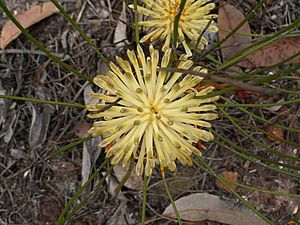Long-leaved cone bush facts for kids
Quick facts for kids Long-leaved cone bush |
|
|---|---|
 |
|
| P. longifolia in the Stirling Range. | |
| Scientific classification | |
| Genus: |
Petrophile
|
| Species: |
longifolia
|
The long-leaved cone bush (scientific name: Petrophile longifolia) is a type of shrub. It grows naturally in the southwest part of Western Australia. You can find it between the city of Albany and the Stirling Range.
What it Looks Like
The long-leaved cone bush is a shrub that grows close to the ground. It has short stems and long, thin leaves. These leaves can be 20 to 40 centimeters (about 8 to 16 inches) long. Each leaf has a sharp point at its end.
Its flowers are creamy white and feel silky. They are about 4 to 6 centimeters (about 1.5 to 2.5 inches) wide. The flowers grow at the ends of short branches. Many small, leaf-like parts surround them.
You can see the flowers in late spring and early summer. After the flowers, the plant grows long, oval-shaped fruits. Like other plants in its group, these fruits only open and release their seeds after a bushfire or when the plant dies.
Naming the Plant
The long-leaved cone bush was first officially described in 1830. A scientist named Robert Brown wrote about it. He used a plant sample collected in 1829 near King George Sound.
The description was published in a book called Supplementum primum Prodromi florae Novae Hollandiae. The name longifolia comes from two Latin words. Longus means "long," and folium means "leaf." So, longifolia means "long-leaved."
Where it Lives
You can find the long-leaved cone bush in several areas of Western Australia. These include the Esperance Plains, Jarrah forest, Swan Coastal Plain, and Warren regions.
It grows in different types of soil. These can be sand, gravel, sandy loam, or clay. It prefers flat, sandy areas.
Growing this Plant
People do not often grow the long-leaved cone bush in gardens. However, it can grow better in humid areas, like gardens on Australia's east coast. This is surprising because it naturally grows in Western Australia.
This plant grows best in places with dry summers. It also needs soil that drains water well. A sunny spot is also important for it to thrive.
Is it Endangered?
Currently, the long-leaved cone bush is not considered to be a threatened plant species.

